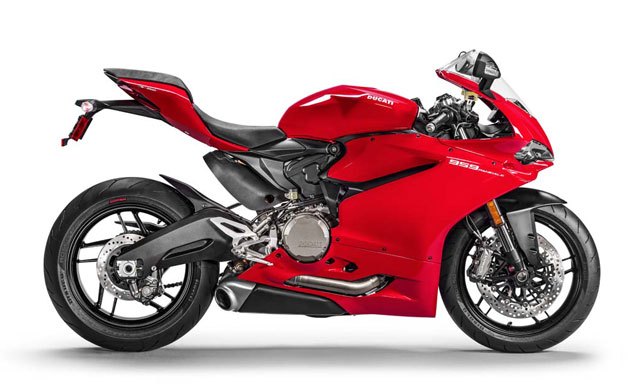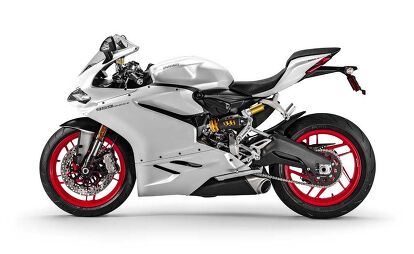2015 EICMA: Ducati 959 Panigale + Video
Increasing the 899 Panigale’s stroke from 57.2 to 60.8mm, while retaining its 100mm bore (3.94 inches), in addition to a bunch more changes, brings us to the 2016 Ducati 959 Panigale. The crankshaft was redesigned to support a brand-new crank journal lubrication system and completely new connecting rods, while compression remains the same 12.5:1.
New piston crowns and DLC (Diamond Like Carbon) coating on the piston pins increase efficiency and reduce friction; new valve covers feature a ribbed design to reduce mechanical noise to help gain Euro 4 compliance. For the same reason, a different cam timing chain was used. Combustion chambers were redesigned to allow larger valves: 41.8mm intakes and 34mm exhausts. The valves are actuated by racing-derived rocker arms, ‘super-finished’ and with a special DLC facing for reduced friction and increased fatigue strength. Valve clearance inspections need to happen every 15,000 miles.
Vacural die-cast engine cases are shared with big bro 1299, though crankcase covers and clutch casings are both aluminum, like the oil sump.
Oval throttle body dimensions with an equivalent diameter of 62mm now get two injectors per cylinder – one above and one below the butterfly, independently controlled by a full Ride-by-Wire system. Ducati’s secondary air system contains HC and CO levels while preventing unburned fuel emissions, helping the 959 become the first Superquadro to obtain Euro 4 status. All that adds up to 157 horsepower at 10.500 rpm, says Ducati.
In other news, the clutch uses a progressive self-servo mechanism that compresses the friction plates when under drive from the engine without any extra effort required from the rider to release the clutch; the same mechanism reduces pressure on the friction plates under decel for “slipper-clutch” action during aggressive downshifting.
That engine continues to be a fully stressed member of the monocoque frame, achieving a wet weight of 440 pounds (20 lbs heavier than a 1299). The Panigale silhouette is updated with a redesigned nose fairing, headlight and tailpiece; the wider nose fairing and screen are supposed to improve aerodynamic performance and add to the aggressive look, also enhanced by larger-section front air intakes.
Did you want electronics? You came to the right bike:
ABS: A Bosch 9MP Brembo three-level system with integrated pressure sensor is fully integrated with the (three) Riding Modes. Level 1 enables sport-oriented ABS intervention with no rear lift-up prevention, Level 2 delivers the same intervention with rear lift-up prevention activated. Level 3 provides more braking stability and rear lift-up prevention.
Ducati Traction Control (DTC): The same software logic developed and used by Ducati Corse for its MotoGP and World Superbike motorcycles offers a choice of eight settings developed to respond to any environmental condition.
Ducati Quick Shift (DQS): Allows virtually instant shifts and can be deactivated for traditional gearbox operation. A microswitch built into the linkage of the gear change lever sends a signal to the main engine ECU. The ECU detects which gear the motorcycle is in and reads the amount of throttle opening before applying a pre-programmed cut in fuel injection and ignition, measured in milliseconds. The 959 additionally features a brand-new, MotoGP-derived gear sensor designed to optimize the electronic shifting strategy while improving performance and comfort.
Engine Brake Control (EBC): Developed by Ducati Corse to help riders optimise vehicle stability in corner entry conditions by equalising the positive, negative and retrograde torque forces applied to the rear tyre under severe engine-braking conditions, EBC monitors throttle position, selected gear and crankshaft de-acceleration rate under heavy braking and administers precise, full Ride-by-Wire throttle openings to balance the torque forces acting on the rear tire. The EBC can be personalized to three different levels.
Riding Modes
Race: “High” Power Mode gives you all 157 hp, reduces DTC intervention, provides race-oriented EBC and front-only ABS with no rear end lift-up prevention. Sport selects the “Medium” Power Mode, all 157 hp but with smoother engine response, slightly increased DTC, sport-oriented EBC with front and rear ABS activation for increased rear end lift-up control. Wet Riding Mode gives 100 hp and an even smoother engine response, maximum DTC intervention, EBC in line with environmental conditions and a more cautious ABS setting.
You can play with it all independently on the 959’s black and white LCD display, along with the optional plug-and-play Ducati Data Analyser with GPS function (DDA+ GPS).
Non-virtual Reality
Front-end geometry unchanged from the 899 consists of 24 degrees rake and 96mm trail. The swingarm pivot is lower by 4mm compared to the 899, contributing to a 1,431mm wheelbase.
Suspension: 43mm Showa BPF forks, fully adjustable for spring preload, compression and rebound damping, house chrome sliders with radial brake caliper mountings. The Big Piston Fork is said to improve damping control at low speed, resulting in improved suspension performance and significant weight savings. An adjustable steering damper is standard.
A fully adjustable side-mounted Sachs monoshock is designed to provide a progressive-rate linkage while acting directly upon the twin-sided swingarm.
Wheels and tires: A 10-spoke 3.5-inch wheel at the front and 5.5-inch wheel at the rear carry Pirelli Diablo Rosso Corsa tires size 120/70 ZR17 and 180/60 x ZR17.
Brakes: Twin radially-mounted M4.32 Brembo monobloc callipers act upon 320mm discs; a single 245mm disc at the rear is gripped by a single Brembo calliper.
Yes, you can get a shiny new 959 Panigale in Ducati Red with black wheels, or in Arctic White Silk with red wheels. It won’t be inexpensive, but it will be more affordable than big bro 1299, and probably every bit as fun to ride, if not a little more.
More by John Burns














































































Comments
Join the conversation
20 pounds heavier than the 1299cc version? Really?
Another beautiful combination of art and engineering that only the Italians seem to do. Will VW be forced to sell Audi,who will then be forced to sell recently acquired Ducati?